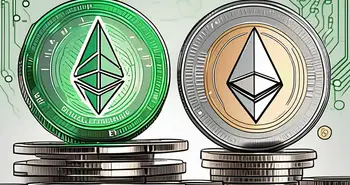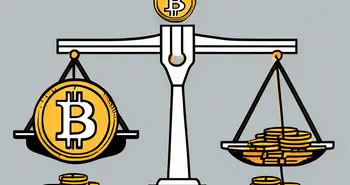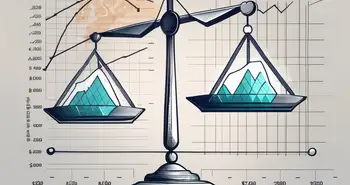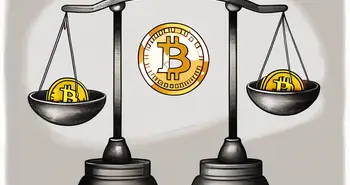Wrapped Ether vs. Ether: Exploring the Pros and Cons of Both Tokens
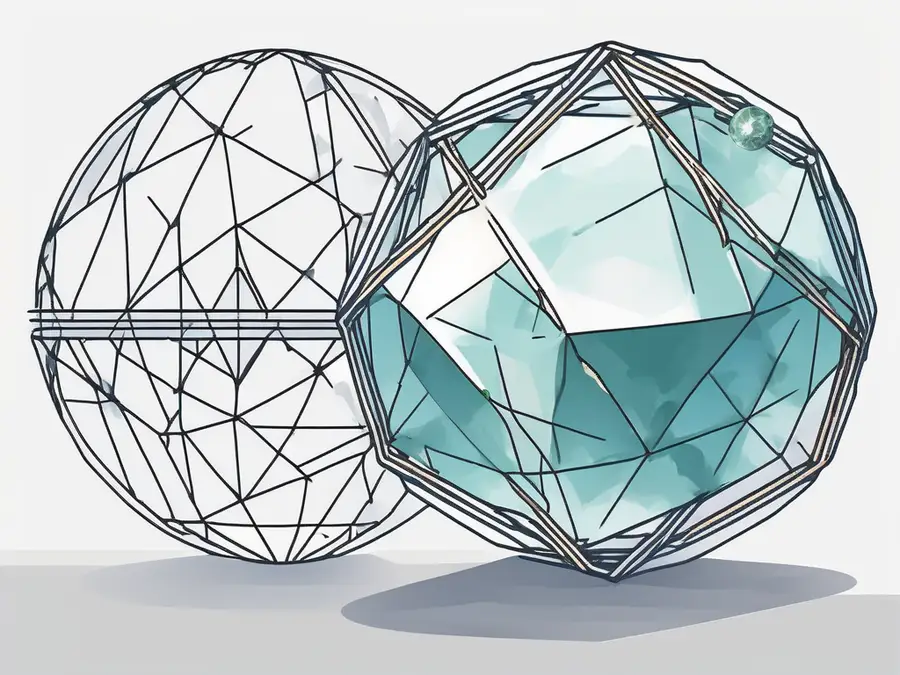
In the exciting world of cryptocurrency, Ether has emerged as one of the leading digital assets. But did you know there is another variation of Ether called Wrapped Ether? In this comprehensive comparison, we will delve into the differences between the two and explore their advantages, use cases, and potential risks.
Understanding the Basics of Ether
Before we dive into the world of Wrapped Ether, let's take a moment to understand the basics of Ether itself. Ether, often referred to as ETH, is the native cryptocurrency of the Ethereum network. It serves as fuel for the network, powering transactions and executing smart contracts.
As the second-largest cryptocurrency by market capitalization, Ether has gained significant popularity among investors and developers alike. Its versatility and wide range of applications have propelled Ethereum to the forefront of the blockchain revolution.
What is Ether?
Ether is a digital currency that allows users to make peer-to-peer transactions and interact with decentralized applications (dApps) built on the Ethereum blockchain. It operates on a proof-of-stake (PoS) algorithm, ensuring a secure and efficient network.
The Role of Ether in Ethereum
Within the Ethereum ecosystem, Ether plays a crucial role in facilitating various functions. Firstly, it acts as a medium of exchange, enabling users to send and receive value across the network. Additionally, Ether is used to pay for computational services, known as “gas,” which ensures transactions and smart contracts are executed.
Furthermore, Ether serves as a measure of value for other tokens and assets built on the Ethereum blockchain. It serves as the benchmark for the valuation of initial coin offerings (ICOs) and token sales, fostering an entire economy within the Ethereum ecosystem.
Developer Community and Industry Adoption
Moreover, Ether has a vibrant developer community that continuously builds and improves upon the Ethereum platform. This community is responsible for creating innovative decentralized applications and smart contracts that leverage the power of Ether and the Ethereum blockchain.
Additionally, the Ethereum network has seen significant adoption in various industries, including finance, supply chain management, and gaming. Companies and organizations are exploring the potential of Ethereum to revolutionize their operations and create new business models.
Recent Development: In 2022, major financial institutions like J.P. Morgan began experimenting with Ethereum-based solutions for improving cross-border payment systems, highlighting Ether's growing influence.
Introduction to Wrapped Ether
While Ether might be the star of the show, Wrapped Ether (WETH) has emerged as an alternative form of Ether. WETH is an ERC-20 token that represents Ether on the Ethereum blockchain but with added functionalities and compatibility.
What is Wrapped Ether?
Wrapped Ether is created by depositing Ether into a smart contract that mints an equivalent amount of ERC-20 tokens. These tokens are then circulated on the Ethereum blockchain, allowing users to trade and interact with them in a decentralized manner.
The Purpose of Wrapped Ether
Wrapped Ether provides enhanced liquidity and accessibility compared to traditional Ether. It enables developers and users to leverage the vast range of functionalities offered by ERC-20 tokens, such as integration into decentralized finance (DeFi) protocols, lending platforms, and decentralized exchanges.
By wrapping Ether into an ERC-20 token, users can unlock new opportunities and explore the rapidly evolving DeFi ecosystem. Wrapped Ether acts as a bridge, connecting the world of Ether and the world of ERC-20 tokens, opening doors to innovation and interoperability.
For example, platforms like Uniswap, a leading decentralized exchange, require tokens to be in ERC-20 format. Therefore, using WETH instead of ETH allows seamless trading with other ERC-20 tokens on these platforms.
The Technical Differences Between Wrapped Ether and Ether
Now that we have a good understanding of Ether and Wrapped Ether, let's delve into the technical differences between the two.
Token Standards: ERC-20 vs. ERC-721
One of the primary distinctions between Ether and Wrapped Ether lies in the underlying token standards. Ether follows the ERC-20 standard, which ensures its compatibility and interoperability with other tokens on the Ethereum blockchain.
On the other hand, Wrapped Ether adheres to the ERC-20 standard, which is designed for fungible tokens. This means that while both Ether and Wrapped Ether are fungible, WETH can be seamlessly integrated into various applications, enabling complex financial products, decentralized exchanges, and lending platforms.
Interoperability and Flexibility
Due to its ERC-20 nature, Wrapped Ether enjoys a higher level of interoperability and flexibility compared to Ether. ERC-20 tokens can be seamlessly integrated into various applications, enabling complex financial products, decentralized exchanges, and lending platforms.
Wrapped Ether's compatibility with ERC-20 standards allows it to tap into the enormous ecosystem of tokens and dApps built on Ethereum. This flexibility widens the options available to users, giving them access to innovative DeFi projects and alternative investment opportunities.
In 2023, Aave, a leading DeFi lending platform, expanded its collateral options to include WETH, allowing users to borrow against their WETH holdings while earning interest.
The Practical Differences Between Wrapped Ether and Ether
Now that we understand the technical aspects, let's explore the practical differences between Wrapped Ether and Ether.
Usage in DeFi Projects
DeFi has emerged as one of the most promising use cases for cryptocurrencies, and Ether is at the heart of this revolution. Ether serves as collateral for decentralized lending platforms, liquidity pools, and yield farming protocols.
On the other hand, Wrapped Ether expands the possibilities even further. It allows users to leverage their Ether holdings by participating in various decentralized finance projects, trading on decentralized exchanges, and earning rewards through liquidity provisioning.
For example, by wrapping Ether into an ERC-20 token, users can provide liquidity for automated market makers on platforms like Uniswap or stake their Wrapped Ether in yield farming protocols like Aave or Compound.
Transaction Speed and Costs
Another practical consideration is the transaction speed and costs associated with Ether and Wrapped Ether. As the native currency of the Ethereum network, Ether transactions tend to be faster and cheaper compared to the conversion process involving Wrapped Ether.
When using Wrapped Ether, users need to wrap or unwrap their Ether to convert it into the respective form. This process requires additional steps, increasing the time and transaction costs. However, the added benefits and opportunities offered by Wrapped Ether can outweigh the extra steps for many users.
During the DeFi summer of 2020, many users preferred WETH for DeFi applications despite the extra steps, due to the seamless integration it offered with various protocols, enabling more efficient yield farming and liquidity provision.
Security Aspects of Wrapped Ether and Ether
Security is of utmost concern in the cryptocurrency space. Let's take a look at the security aspects of both Ether and Wrapped Ether.
Smart Contract Risks
Both Ether and Wrapped Ether rely on smart contracts to operate on the Ethereum blockchain. While smart contracts offer immense potential, they also carry inherent risks. Vulnerabilities or coding errors in smart contracts can lead to substantial financial losses.
It is crucial for users to exercise caution and conduct thorough due diligence when interacting with smart contracts. Additionally, reputable platforms and audited contracts play a vital role in mitigating such risks.
Centralization vs. Decentralization
Ether operates in a decentralized manner, with no single entity having control over the network. This decentralized structure ensures greater security and resistance to censorship.
Wrapped Ether, on the other hand, possesses elements of centralization due to the involvement of custodians who facilitate the wrapping and unwrapping process. While custodial services specialize in security, they introduce a central point of failure and dependence.
When dealing with Wrapped Ether, it is essential to consider the balance between enhanced functionality and potential centralization risks.
In 2021, a centralization issue was highlighted when several Wrapped Bitcoin (WBTC) custodians were found to hold significant power over the asset's movement, prompting discussions about decentralized alternatives.
FAQ
Q: What is the difference between Ether and Wrapped Ether?
A: Ether is the native cryptocurrency of the Ethereum network, whereas Wrapped Ether is an ERC-20 token that represents Ether on the Ethereum blockchain but with added functionalities and compatibility.
Q: What are the advantages of using Wrapped Ether?
A: Wrapped Ether provides enhanced liquidity, compatibility with ERC-20 tokens, and access to a wide range of decentralized finance applications and trading platforms.
Q: Is Wrapped Ether more secure than Ether?
A: Both Ether and Wrapped Ether rely on smart contracts and carry inherent risks. While Ether operates in a decentralized manner, Wrapped Ether introduces elements of centralization through custodial services.
Q: Can I convert between Ether and Wrapped Ether?
A: Yes, you can convert Ether to Wrapped Ether and vice versa by wrapping or unwrapping your Ether through supported platforms and custodians.
With Ether and Wrapped Ether, users can choose the option that aligns with their goals and priorities, empowering themselves to explore the dynamic world of cryptocurrencies and DeFi. Choose wisely and embrace the decentralization revolution!
Ready to take your trading to the next level with the flexibility of Ether and Wrapped Ether? Look no further than Morpher, the revolutionary trading platform that's redefining the investment landscape. With Morpher, you can enjoy zero fees, infinite liquidity, and the ability to trade a diverse range of assets, including cryptocurrencies like ETH and WETH. Embrace the power of fractional investing, short selling, and up to 10x leverage to maximize your trading strategies. Your safety is our priority, with a non-custodial Morpher Wallet that puts you in control. Experience the future of trading on the Ethereum Blockchain with Morpher. Sign Up and Get Your Free Sign Up Bonus today, and join the community of traders who are already navigating the dynamic world of cryptocurrencies and DeFi with confidence.

Disclaimer: All investments involve risk, and the past performance of a security, industry, sector, market, financial product, trading strategy, or individual’s trading does not guarantee future results or returns. Investors are fully responsible for any investment decisions they make. Such decisions should be based solely on an evaluation of their financial circumstances, investment objectives, risk tolerance, and liquidity needs. This post does not constitute investment advice.

Painless trading for everyone
Hundreds of markets all in one place - Apple, Bitcoin, Gold, Watches, NFTs, Sneakers and so much more.

Painless trading for everyone
Hundreds of markets all in one place - Apple, Bitcoin, Gold, Watches, NFTs, Sneakers and so much more.

